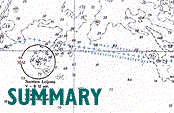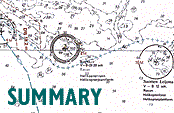 |
Failure
- The ESTONIA's bow visor locking devices failed due to wave-induced
impact loads creating opening moments about the deck hinges.
- The ESTONIA had experienced sea conditions of equivalent severity to
those on the night of the accident only once or twice before on a voyage
from Tallinn to Stockholm. The probability of the vessel encountering
heavy bow seas in her earlier service had been very small. Thus, the
failure occurred in what were most likely the worst wave load conditions
she ever encountered.
- The visor attachments were not designed according to realistic design
assumptions, including the design load level, load distribution to the
attachments and the failure mode. The attachments were constructed with
less strength than the simplistic calculations required. It is believed that
this discrepancy was due to lack of sufficiently detailed manufacturing
and installation instructions for certain parts of the devices.
- The bow visor locking devices should have been several times stronger
to have a reasonable level of safety for the regular traffic between
Tallinn and Stockholm.
- At the time of the ESTONIA's construction, despite scattered
information, the industry's general experience of hydrodynamic loads on large
ship structures was limited, and the design procedures for bow doors
were not well-established.
- The classification society design requirements for bow doors became
more clearly defined and the design load levels were in general increased
after the ESTONIA had been built but, according to established practice,
the new rules did not apply to existing vessels.
- Numerous bow visor incidents occurred prior to the accident on vessels
built before and after the ESTONIA for the Finland-Sweden traffic.
These included an incident on the DIANA II, a near-sister vessel to the
ESTONIA, but the experience did not lead to systematic inspection and
requirements for reinforcement of visor attachments on existing vessels.
- Information on bow visor incidents was not systematically collected,
analysed and spread within the shipping industry. Thus masters on board had,
in general, very little knowledge of the potential danger of the bow
visor closure concept.
Capsize
- The ESTONIA capsized due to large amounts of water entering the
car deck, loss of stability and subsequent flooding of the
accommodation decks.
- The full-width open car deck contributed to the rapid increase in the list.
The turn to port - exposing first the open bow and later the listed side to
the waves - shortened the time until the first windows and doors broke,
which led to progressive flooding and sinking.
- The design arrangement of bow ramp engaging with visor through the
box-like housing had crucial consequen-ces for the development of the
accident.
- Non-compliance with the SOLAS regulations regarding the upper
extension of the collision bulkhead, accepted originally by the national
administration, may have contributed to the vessel's capsizing.
Action by the crew
- The initial action by the officers on the bridge indicates that they did
not realise that the bow was fully open when the list started to develop.
- The bridge officers did not reduce speed after receiving two reports of
metallic sounds and ordering an investigation of the bow area. A rapid
decrease in speed at this time would have significantly increased the
chances of survival.
- The visor could not be seen from the conning position, which the
Commission considers a significant contributing factor to the capsize. In
all incidents known to the Commission where the visor has opened at sea
due to locking device failure, the opening was observed visually from the
bridge and the officers of the watch were able quickly to take appropriate
action.
- There are indications that the crew did not use all means to seek or
exchange information regarding the occurrence at a stage when it would still
have been possible to influence the development of the accident. The
bridge crew apparently did not look at the TV monitor which would have
shown them that water was entering the car deck; nor did they ask those in
the control room from where the ingress was observed, or get information
from them.
- The position sensors for signal lamps showing locked visor were
connected to the side locking bolts in such a way that the lamp on the
bridge showed locked visor even after the visor had tumbled into the sea.
The indirect information on the status of the visor was thus misleading.
The signal lamp for locked ramp was most likely not on because one of the
locking bolts was not fully extended. There was thus no lamp warning when
the visor had forced the ramp partly open and it was resting inside the visor.
- It is most likely that the crew were unaware of visor incidents involving
other vessels, in particular the DIANA II.
Evacuation
- The rapid increase in the list contributed to the large loss of life.
- The lifeboat alarm was not given until about five minutes after the list
developed, nor was any information given to the passengers over the
public address system. By the time the alarm was given, the list made
escaping from inside the vessel very difficult. This together with problems
in using lifesaving equipment contributed to the tragic outcome.
Rescue operation
- The alarming of helicopters was late.
- The helicopters had a key part in the rescue operation by rescuing most
of the people who had succeeded in climbing onto liferafts or lifeboats.
- One rescue man per helicopter was not enough due to the very exhausting rescue work.
- It is deemed inappropriate for helicopters to carry journalists in critical situations and where they may encroach on the privacy of survivors.
- The main reasons for the delay in issuing alarms in general were that the distress traffic was conducted separately from MRCC Turku, and that there was only one person on duty at MRCC Turku, at MRCC Helsinki and at Helsinki Radio, respectively.
- In the Finnish MRCCs the instructions regarding distress traffic were inadequate.
- The lifesaving equipment of vessels participating in the rescue operation proved unsuitable for rescuing people from the water in the prevailing heavy weather conditions.
 |
 |















